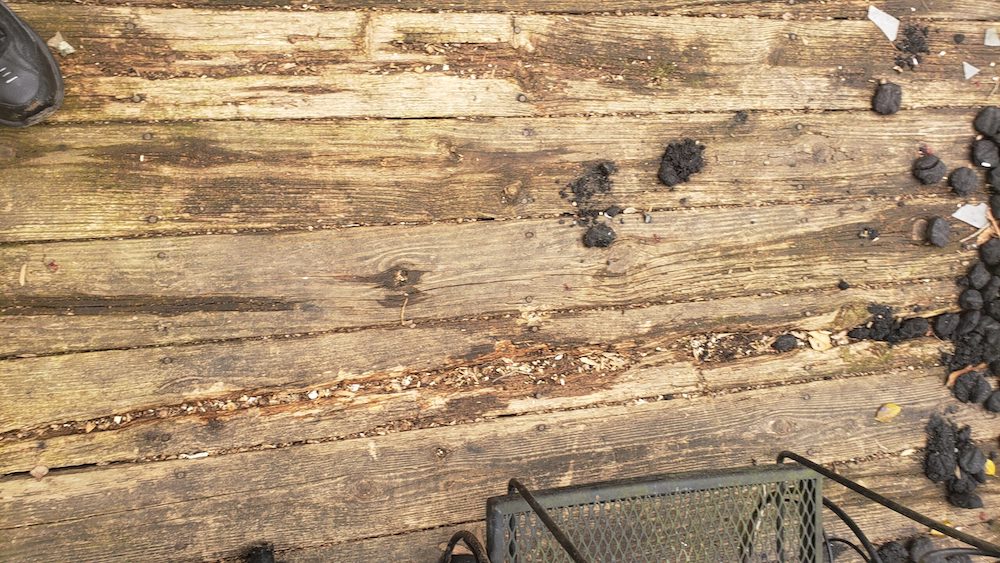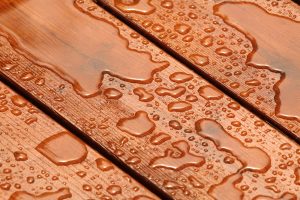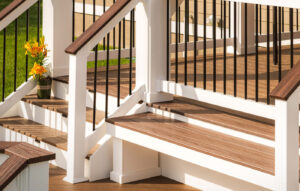If you’re looking to give your deck a fresh look with a new stain, then it’s important that you know some things before getting started. That way, you can do everything in your power to make sure that the job turns out great and lasts for a long time. We’ve put together this blog post to give you the inside scoop, and some red flags that could indicate your deck is in need of more than just a new coat of paint.
How close is your deck to the ground?
Decks closer to the ground tend to trap heat and moisture. And wood in contact with the ground acts like a wick, continually drawing water up from the soil.
Moisture negatively impacts your deck in two ways. First of all, that moisture accelerates the process of wood rot. This not only looks bad, but it can become a serious safety issue. Secondly, moisture prevents stain from properly bonding to the wood fibers. The result is that the stain will fail sooner than you’d expect!
Does your deck have enough ventilation?
Decks low to the ground limit airflow and trap hot steamy air which makes it difficult for anything under there to stay dry.
The level of ventilation under the deck can have a big impact on what it will take to properly stain the wood. If you’re unsure about your home’s soffit and fascia situation (the structure around the edges of your roof), you should check with a contractor before continuing this project.
When water and algae are already in the wood
Moisture, algae, and staining all create problems for preparing a deck to be properly stained. What makes this difficult is often how deep the issue has penetrated into the wood. The presence of these may interfere with how well the stain bonds to the wood. This can lead to an inconsistent result, or worse, the stain failing altogether. Sanding often helps but may not completely resolve the problem. In some cases, careful pressure washing is required to better prepare the wood to absorb the new stain.
If you’re concerned about about the condition of your deck, it might be time to look into professional restoration services: How to tell when you need deck restoration
How much will sanding help?
Sanding your deck is one of the first steps to prepare it for staining. This will remove any dirt and dust that covers up stains on the wood’s surface. But while sanding old wood may smooth the surface and make it look newer, there’s nothing you can do about cracks. The result will be helping minor cracks look less obvious, but they’ll get worse over time!
Most wood filler/putty is not designed to hold through harsh winters or hot summers. These products also may not take the new stain well or at all, resulting in a poor look.
Solid stains vs. Oil stains
There are pros and cons to each type of deck stain. Solid stains are a beautiful way to make your deck appear new. The downside is that the color will be very uniform and bright, sometimes making it hard to distinguish between boards or cracks in the wood grain.
Oil stains can add depth of color with their rich blend of pigments, but they can also soak up more than a solid stain, so it could require more coats to fully cover the wood.
Oil stains are also not as protective from UV light or harsh weather, but they penetrate deeply into the wood and give it beautiful variation in color that cannot be achieved with any other type of finish.
The reality is there’s no guaranteed process, because there is no one-size-fits all solution. That’s why working with a professional contractor is so important. Our team is trained in the best practices of deck restoration and replacement, and can help you choose the right kind of project based on the desired look, surface, condition and location of your deck.If you’d like to find out more ways the DeckGuru team can help you with your next project, contact us today!
If you’re looking to give your deck a fresh look with a new stain, then it’s important that you know some things before getting started. That way, you can do everything in your power to make sure that the job turns out great and lasts for a long time. We’ve put together this blog post to give you the inside scoop, and some red flags that could indicate your deck is in need of more than just a new coat of paint.
How close is your deck to the ground?
As decks get closer to the ground, they trap heat and moisture which accelerates the process of wood degrading. Wood against the ground acts like a wick, continually drawing water up from the soil.
Wood that is moist can’t absorb as much stain, which ultimately means a shorter life span for your deck. In addition, moisture speeds up wood rot so any stains applied now will start failing sooner than you might expect.
Does your deck have enough ventilation?
Decks low to the ground limit airflow and trap hot steamy air which makes it difficult for anything under there to stay dry.
The level of ventilation under the deck can have a big impact on what it will take to properly stain the wood. If you’re unsure about your home’s soffit and fascia situation (the structure around the edges of your roof), you should check with a contractor before continuing this project.
When water and algae are already in the wood
A lot also depends on how much algae or water staining there is. The presence of either can make it difficult to predict what we’ll find when the deck is stripped down to bare wood. The natural oils in these plants don’t always react well to staining. Sanding may remove them, or we may find that careful pressure washing is required, to ensure the wood is clean enough to absorb the new stain.
If you’re worried about this, it might be time to look into professional restoration services: How to tell when you need deck restoration
How much will sanding help?
Sanding your deck is one of the first steps to prepare it for staining. This will remove any dirt and dust that covers up stains on the wood’s surface. But while sanding old wood may smooth the surface and make it look newer, there’s nothing you can do about cracks. Minor cracks are less obvious, but they’ll get worse over time!
Most wood filler/putty is not designed to hold through harsh winters or hot summers. These products also may not take the new stain well or at all, resulting in a poor look.
Solid stains vs. Oil stains
There are pros and cons to each type of deck stain. Solid stains are a beautiful way to make your deck appear new. The downside is that the color will be very uniform and bright, sometimes making it hard to distinguish between boards or cracks in the wood grain.
Oil stains can add depth of color with their rich blend of pigments, but they can also soak up more than a solid stain, so it could require more coats to fully cover the wood.
Oil stains are also not as protective from UV light or harsh weather, but they penetrate deeply into the wood and give it beautiful variation in color that cannot be achieved with any other type of finish.
The reality is there’s no guaranteed process, because there is no one-size-fits-all solution. That’s why working with a professional contractor is so important. Our team is trained in the best practices of deck restoration and replacement, and can help you choose the right kind of project based on the desired look, surface, condition and location of your deck.
If you’d like to find out more ways the DeckGuru team can help you with your next project, contact us today!







